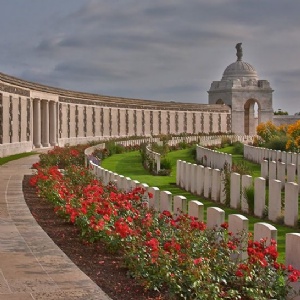Published on 11/11/25

Helen Kedie, Head of English and Natalie Stanley, Head of History and Politics tell us all about the Year 9s battlefields trip.
The Year 9 trip to the battlefields of Belgium and France always begins early, and this year was no different. At the crack of dawn, on Wednesday 2 July, 16 staff and roughly 140 sleepy students departed from Trumpington Park and Ride and travelled by coach and ferry to our first stop in the Belgian town of Ypres. It’s an appropriate place to start - between 1914 and 1918 Ypres was a vital defensive point for the Allies and was witness to some truly terrible fighting and shelling. Ypres itself was virtually destroyed - the magnificent Cloth Hall that stands in Ypres today was razed to the ground and then rebuilt, from the ruins and rubble, after the war.
A visit to Tyne Cot, one of the largest of the Commonwealth cemeteries, brought home to the students the scale and devastation of the war. Its 12000 graves bear silent and enduring witness to the terrible loss of life during the Battle of Passchendaele, a battle which is synonymous with the thick, deep and deadly mud that Wilfred Owens described as an ‘octopus of sucking clay’. German cemeteries also featured on the itinerary. The German soldiers were sons and fathers too and this trip is a means of remembering and commemorating the shared human cost of war. Day two and three were spent in France, travelling around the various sites of the Somme. To stand beside the grave of Lieutenant Hodgson in the Devonshire trench, and hear students recite his poem ‘Before Action’ which had been published on the 29 June, 1916, is always a deeply poignant moment. He was killed a few weeks later. He was 23.
As the Anglia guides expertly brought this war to life, a war that was fought on an unprecedented scale, a war in which poison gas was used for the first time, a war whose new technological innovations would cost the lives of millions of soldiers worldwide, staff could see the students’ understanding of this global conflict deepen and mature. With each passing year (it’s 107 years since the armistice of 11November 1918) we wonder, as trip leaders, if this war still has relevance for the younger generations. Once again, we were convinced that it does. Our students behaved respectfully, asked sensitive and thoughtful questions, and often struggled to hide their shock or horror as they learned new details about this critical period in history.
One of our last visits, the Thiepval Memorial, was a fitting way to end the tour. It bears the names of 72,000 soldiers who died on the Somme and have no known grave. 90% of these men died between July and November 1916. Visiting the battlefields continues to provide a unique opportunity to experience, in a visceral way, the pity of war. Not just World War One, but all wars.